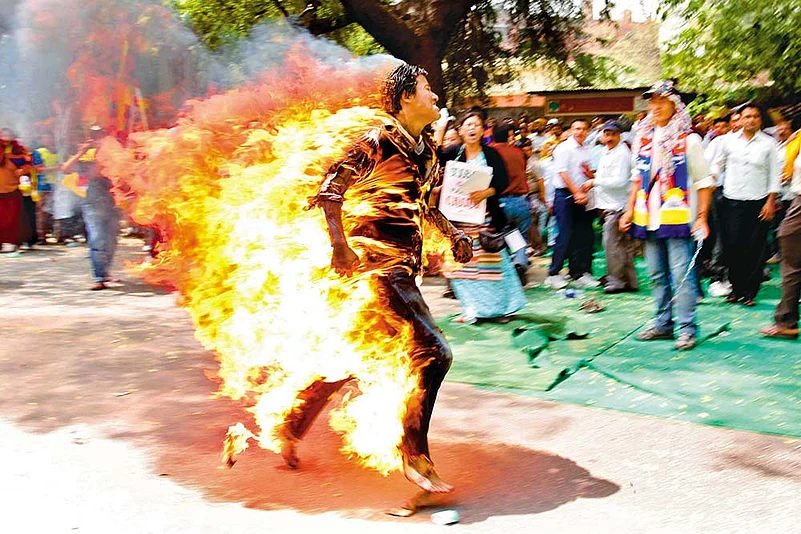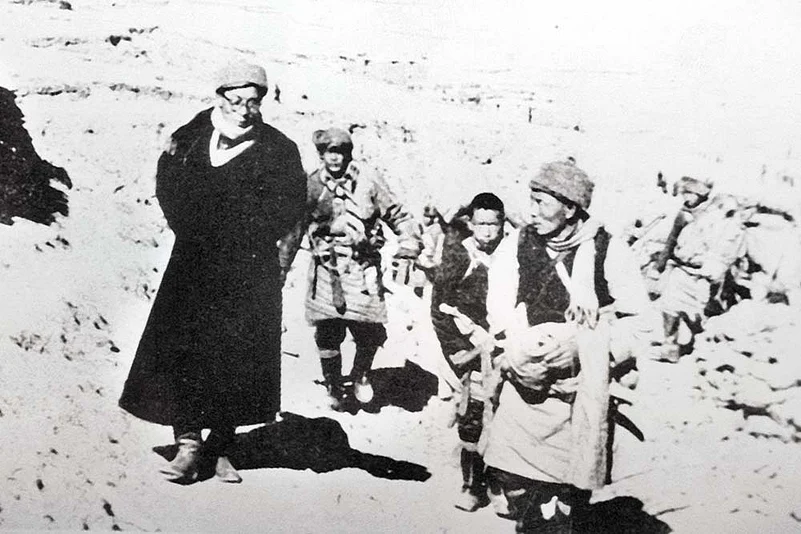When Nirupama Menon Rao was posted as ambassador to Beijing in 2008, she was summoned late one night to the Chinese Foreign Office. Receiving a tongue-lashing at 2 am is not usually part of the call of duty for a career diplomat, but there were exigent reasons! The Chinese wished to register their anger against Tibetan refugees blocking the Olympic torch being carried through Indian cities, en route to its final destination across the MacMahon line: the Beijing Olympics were around the corner. It was also the 50th anniversary of the Dalai Lama’s flight from Tibet, and just as in 2006, ahead of President Hu Jintao’s India visit, there was a spurt of violence in Tibet and neighbouring provinces, besides protests and self-immolations by Tibetan refugees across India. Enough to get the mandarins touchy.
The implication, albeit unspoken, was that New Delhi was somehow complicit in all that. Ms Rao, who went on to become foreign secretary the next year, had to explain the basics: that in a democracy like India, protests such as these are par for the course; indeed, that there are even protests against the Indian government. But beyond the words uttered on both sides, there lurked a story. Beijing must have known fully well, then, as it does now, that while New Delhi has never openly played the Tibet card, it’s one that has been in play, in one form or the other, since 1962.
ALSO READ: 1962 Redux?
On one side, disavowals of support to the Tibetan cause have a long, bipartisan history. Successive prime ministers have stuck doggedly to that line—all the way from Lal Bahadur Shastri to Atal Behari Vajpayee, Dr Manmohan Singh and even Narendra Modi. It was Vajpayee who formally recognised Tibet as a part of China in 2003, and Modi even failed to wish the Dalai Lama on his 85th birthday in 2020. This endemic reluctance to even take the name of Tibet was—and is—doubtless coloured by New Delhi’s wish not to upend the ‘peace and tranquility’ on the border.
Episodically, that strategic silence has been proved to be myopic. But it’s a silence not shared by the intelligence and strategic community; and certainly not by the Tibetans who fled when Mao Zedong’s brutish PLA forcibly ‘integrated’ Tibet into the very womb of Chung Kuo in 1951—marching into Lhasa, and over the years destroying and looting the Dalai Lama’s Norbulingka palace and a string of monasteries, hounding herdsmen, and imposing punishing taxes on landowners who were humiliated and tortured for ‘crimes against the people’.
ALSO READ: Uneasy Tango Of Big Ambitions
The crackdown set off an exodus of angry Tibetans, thirsting for revenge—what most people don’t know is that they signed on in their hundreds to become members of a pan-Tibetan resistance force drawn from the Kham and Amdo regions of Tibet. The Dalai Lama’s own expeditious escape saw him shepherded to safety through the precarious mountain passes over 14 days, and brought into India by the then envoy to Lhasa, P.N. Menon, at Bomdila. P.N. Menon, incidentally, is the father of Shivshankar Menon, who would go on to become India’s National Security Advisor under Dr Manmohan Singh.
Now, as the four-month-long China-India standoff skates dangerously close to an all-out confrontation, the taking of Black Top in Chushul, Ladakh, on August 31 carried an extra buzz. Helming the operation was the Special Frontier Force, a hitherto secret Tibetan force that morphed from its first raw avatar, Establishment 2-2, into what it is today. Their triumphant ‘coming out’ at Chushul Valley, the site of a famous ‘last man, last round’ battle by the Indian Army in 1962, has overnight turned the unit into the stuff of legend.
So who are they? The Tibetans in the ranks of the SFF’s original avatar were drawn from resistance fighters who rose up against Communist China in the mid-fifties and found in US President Dwight Eisenhower and CIA director Alan Dulles two unlikely mentors who backed their rebellion. A backing they did not get from Nehru who, in a face-to-face meeting with the Dalai Lama, after he had granted the Tibetan leader asylum, had famously scoffed at his words: “You say you want independence and in the same breath, you say you do not want bloodshed. Impossible!”
ALSO READ: Do Hold The Horses
The PLA’s destruction of Tibetan religious symbols and the later imposition of Han culture would see hitherto peaceful monks take to arms—it would also spark the Khampa rebellion. The war-like Khampas—also called the ‘Buddha warriors’—were said to be feared even by the Chinese for their guerrilla skills. Led by Gompo Tashi Andrugtsang, head of the famed Lithang monastery, one of those levelled by the PLA, memories of the rebellion continue to haunt Beijing even today.
Gompo Tashi’s Tibetan resistance movement would be taken over by the Dalai Lama’s brothers, Gyalo Thondup and Thubten Norbu, operating from Kalimpong. The brothers had opened lines to Washington. Gyalo first approached the CIA as early as 1952, offering the services of some 27 Khampas to the CIA. That small band of Tibetans, posing as Bengalis, were the first to be taken across the border to then East Pakistan, and flown out from a secret airfield near Dhaka to a US airbase in Saipan, the CIA station in the Mariana Islands. There, they learned how to handle radios, send messages on Morse code, how to operate a parachute—in short, everything needed to conduct clandestine operations inside Tibet. Through the years, groups of several hundred Khampas would be trained at other US bases and dropped into Tibet, melding into the community as nomads, supplying local resistance groups with arms, cash and communication equipment. All the while, without Indian involvement.

A Tibetan sets himself on fire during a protest against Chinese occupation of Tibet, in Delhi in 2012.
But with the Soviet Union growing into their primary foe in the geopolitical sweepstakes and China less so, as the Vietnam war took its toll, the US pulled the plug on the Tibetan resistance in ’64, opening a backchannel to Beijing. But by 1962, after the drubbing at the hands of the PLA, the value of having eyes and ears behind Tibetan lines was not lost on the chief of India’s Intelligence Bureau, B.N. Mullik. Credited with the idea of having a Tibetan counter-intelligence arm, Mullik entrusted the task to Maj Gen Sujan Singh Uban, then a brigadier, and his protégé, new recruit M.K. Narayanan, both operating out of a tiny room that had space for just a table and two chairs. In a mere 14 months, Brigadier Uban and Narayanan—who would later head IB and also become India’s NSA under Dr Singh—would set up the innocuously named Aviation Research Centre, the air wing of a highly effective intelligence gathering and subversive network inside Tibet that worked closely with the IB and CIA, specialising in sabotage and snooping. The ARC, a guerrilla unit under the Indian Army drawn entirely from Tibetan exiles, would go on to operate in East Pakistan, during Operation Blue Star, in Sri Lanka, in the Kargil war and even in Afghanistan.
A new generation of Tibetan exiles who grew up in the settlements in and around Dharamshala in the north and Bylakuppe in the south, fiercely loyal to India, have not sworn off from settling scores with China for its brutal occupation of their homeland, and the forced flight of their spiritual leader to exile in India in March 1959. It would be a matter of much chagrin for China’s strongman President Xi Jinping and the PLA’s Western Command that—despite its tactical and vastly superior technological edge, which has enabled it to hold a swathe of territory in Ladakh, from Depsang to Hot Springs to Pangong Tso—the grit of this new breed of Indian soldier, built for mountain warfare, forced a Chinese retreat, however temporary, after opening fire at Mukhpari peak on Monday night.
Prime Minister Modi, who some sources say rebuffed a phone call from Xi, may or may not have wanted to play the Tibet card openly—unlike one of his chief foreign policy advisors, Ram Madhav, who attended the funeral of SFF Tibetan soldier Nyima Tenzin, who died in the August 31 encounter. Either way, it has already upset the Chinese. But that offers enough room for PM Modi to examine whether he can review Vajpayee’s wholly unwarranted placation of China with his recognition of Tibet as a part of ‘One China’. One natural route would be to raise China’s human rights violations in the Uighur province and in Tibet, just as Beijing has done repeatedly on Kashmir through its proxy, Pakistan. The meeting between foreign ministers S. Jaishankar and Wang Yi could be a possible precursor, insiders say, to a Modi-Xi summit. The Tibetans are surely hoping it’s payback time. A final reversal of Nehru’s abandonment of Tibet to the maws of the Cold War would be a fitting twist to a long, secret history.
(Views expressed are personal)
Neena Gopal worked as Foreign Editor for Gulf News, covering the first Gulf War in 1990, war-torn Iraq and its neighbours through the second Gulf War, as well as India and its immediate neighbourhood. She has reported from various hotspots, including the LTTE-held areas in northern Sri Lanka and Afghanistan soon after the ouster of the Taliban. Until recently the Resident Editor of Deccan Chronicle, she is the author of 'The Assassination of Rajiv Gandhi', a retelling of the last interview that India's youngest prime minister gave her before his death.















